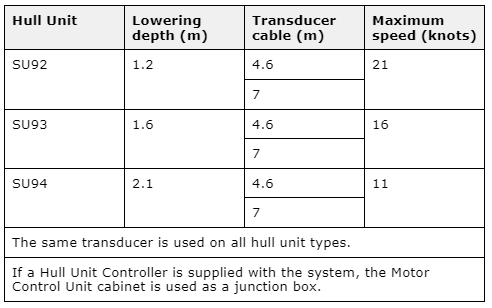Simrad SU90 Hull units
The Simrad SU90 fish-finding sonar can be provided with one of the following hull units. Which hull unit to choose depends on the size of your vessel and the operational requirements.
The hull unit provided with the Simrad SU90 system is designed to lower the transducer below the ship's hull when the SU90 is used. When the SU90 is turned off, the transducer is hoisted for protection.

(A) Hand crank for manual hoisting and lowering
(B) Transducer cable with a plug that connects to the Transceiver Unit
(C) Hoist motor
(D) Motor Control Unit
(E) Transducer shaft
(F) Transducer shaft sleeve
(G) Mounting flange
(H) Installation trunk (not a part of the hull unit)
(I) Transducer
The Simrad SU90 sonar system can be provided with one of the following hull units.

The hull unit is a large mechanical construction. It is mounted on the top of the installation trunk. The installation trunk penetrates the ship’s hull and allows the transducer to be lowered into the sea.
The purpose of the Motor Control Unit is to control the hoisting motor on the hull unit. When you make the relevant commands, the Motor Control Unit will start and stop the motor. It will also make sure that the motor rotates the correct way. The motion sensor for the built-in electronic stabilization of the sonar beams is provided.
- To lower the transducer, press Down on the Operating Panel. The Down indicator lamp flashes to indicate transducer movement and an audible signal is sounded. When the bottom position has been reached, the indicator lamp is lit, and the audible signal stops.
- To retract the transducer, press Up on the Operating Panel.
The transducer can also be lowered to any selected middle position. Press Middle on the Operating Panel.
In case of power failure, the transducer can be raised or lowered manually using a hand crank.
If you forget to hoist the transducer before the sonar is turned off, the transducer is hoisted automatically before the power is disconnected. The transducer is also hoisted automatically if a serious malfunction occurs in the communication between the bridge and the hull unit.
Caution: If the transducer hits larger objects or the bottom, the transducer shaft may be bent, or - in the worst case - it can be broken off. A broken transducer shaft will cause water leakage through the top of the shaft. If you suspect the transducer shaft is seriously damaged with holes, do not retract it to its upper position. To prevent serious damage to the vessel or the vessel's stability, you must have a water pump and a warning system in the sonar room.